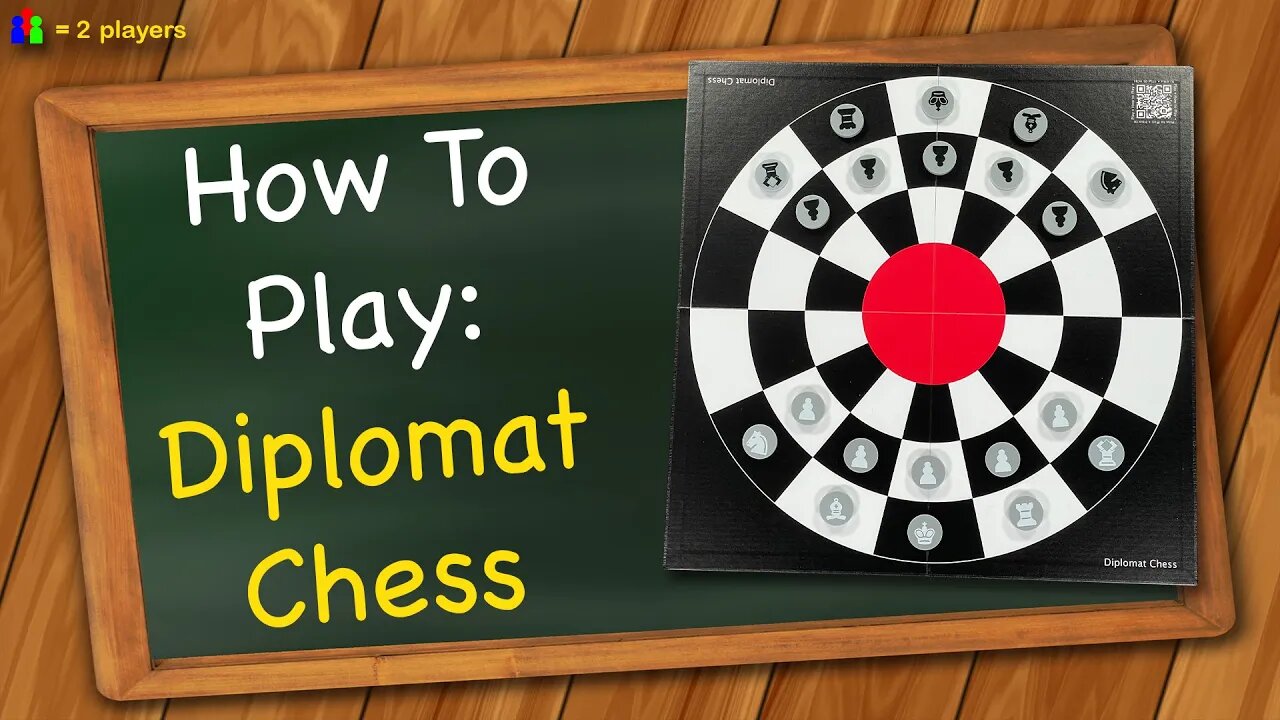Premium Only Content

How to play Diplomat Chess
Learn the rules to Diplomat Chess quickly and concisely - This video has no distractions, just the rules. For a refresher of the original Chess rules, check out this video: https://youtu.be/fKxG8KjH1Qg
Play chess online for free here:
https://link.triplesgames.com/Play-Chess-Online
(As an chess.com affiliate we earn from qualifying subscriptions)
Buy Double-Sided Chess Discs here: https://buy.triplesgames.com/DoubleSidedChessDiscs
Buy Double-Sided Chess Fairy Pieces here: https://buy.triplesgames.com/ChessFairyPieces1
Buy the board: https://buy.triplesgames.com/DiplomatChess
RULES
Layout the board and setup 5 pawns on the middle row on one side. Behind those from left to right goes: Horse, Bishop, King, Rook, Diplomat. There is no queen, but If you don’t have a diplomat piece, you can use a queen to represent one. Repeat this arrangement on the other side so the pieces line up with each other through the center.
The center is a space that can be occupied and it is considered orthogonally and diagonally connected to every adjacent space. Pawns still move 1 space forward but a forward movement is any space that puts the pawn closer to the starting space of the opponent’s king. Therefore, your pawns may move towards the center, laterally around the circle, or through the center, or any combination thereof so long as the move puts them closer to the starting space of the opposing king than the space they are currently on. This does not mean it has to be THE closest space available, just closer than what it currently is. When a pawn is in the center space it may move out of the center to any of the 7 spaces on your opponent’s side of the board then proceeds with movement towards the starting space of the opposing king. Pawn still capture diagonally in front of them, which translates to being able to capture to either side of any space they can move to. Any pawn adjacent to the center may capture to the center. Your pawn in the center may capture to any adjacent space on your opponent’s half of the board, you cannot capture backwards to any adjacent space on your own side of the board. Pawns are not allowed the initial 2 step move nor are they allowed to En passant. Pawns are promoted when they move to any of the opponent’s rear rank starting positions.
The rook can move laterally around the circle as many spaces as are available but may not end a movement in the same space it started. The rook can travel through the center in a single move to a space on the opposite side or it can stop in the center. A rook in the center space can reach any space on the board in a straight line outward unless its path is obstructed by another piece. You are not allowed to castle.
The bishop’s diagonal movement travels through the opposite corner of the space the piece entered, you may not change directions mid move. The bishop may travel through the center. To do so, the bishop travels straight across the center to the opposite color, then diagonally in the same diagonal direction that it began the move with. It is as if the two adjacent spaces of the center are the same space. If the Bishop started the move adjacent to the center, then it travels directly across the center to the other side then it may travel diagonally in either direction towards the outside of the board. A Bishop in the center space can reach any space on the board in a diagonal line outward unless its path is obstructed by another piece. The bishop’s move may not bounce off the outside edge of the board.
The Horse has the same movement as the Knight but it may not travel through the center space to the other side. If the horse is on the middle or outer ring, in addition to its normal movement, it may also move to the center. If the horse in the center, it may move to any of the spaces in the two inner rings. The horse moves directly to its space, passing over any piece in the way.
The Diplomat, which may be represented by a queen or another piece, may move one space in any direction to any unoccupied space. The diplomat may not capture pieces but instead may suborn them. Instead of moving, the diplomat can suborn an adjacent enemy piece to your side. Simply leave the diplomat stationary and replace your opponent’s piece with the same piece of your color. You now control that piece and all its abilities and may move it as soon as your next turn. You may not move a diplomat and suborn a piece in the same turn. You may only suborn 1 piece per turn, even if multiple pieces are adjacent. You may suborn any piece except for the king. The diplomat may not put the king in check.
The first player to checkmate or stalemate their opponent, wins. If the same position is repeated 3 times then the game is a draw.
-
 2:21
2:21
Triple S Games
1 year ago $0.06 earnedHow to play Cruise Pawns
932 -
 LIVE
LIVE
Hard Lens Media
1 hour agoTRUMP Addressing The Nation As He Announced US Bombed Three Iranian Nuclear Sites
367 watching -
 16:46
16:46
Exploring With Nug
11 hours ago $6.29 earnedWe Recovered a Stolen Chevy Malibu From the River! Underwater Vehicle Search!
79.4K4 -
 LIVE
LIVE
Spartan
2 hours agoPro Halo Player | Sens Crisis Grind
180 watching -
 LIVE
LIVE
Mally_Mouse
3 hours agoSpicy Saturday!! - Let's Play: PEAK
336 watching -
 24:53
24:53
MYLUNCHBREAK CHANNEL PAGE
1 day agoFault Lines are GATES - Pt 1
54.3K24 -
 2:38:42
2:38:42
Barry Cunningham
9 hours agoIS PRESIDENT TRUMP DIRECTING A MOVIE...OR IS IT CHESS? AND MORE NEWS!
56.7K30 -
![Nintendo Switch It UP Saturdays with The Fellas: LIVE - Episode #24 [Mario Party Superstars]](https://1a-1791.com/video/fww1/49/s8/1/X/M/v/V/XMvVy.0kob-small-Nintendo-Switch-It-UP-Satur.jpg) LIVE
LIVE
MoFio23!
10 hours agoNintendo Switch It UP Saturdays with The Fellas: LIVE - Episode #24 [Mario Party Superstars]
77 watching -
 15:19
15:19
T-SPLY
23 hours agoMayor Busted: Nashville Mayor Not Concerned Over Leaking Federal Agents Information!
69.2K116 -
 14:05
14:05
Mrgunsngear
11 hours ago $4.12 earnedHolosun 507 Comp Review: The Best Pistol Optic?
58.7K9